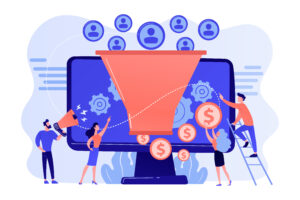Create The Movement Podcast #8
Brad Post, Create the Movement
Josh Rich, Create the Movement
Russ Frazier – Visigility
Brad Post, Create the Movement: Welcome to Create the Movement podcast. We are joined with a special guest today. We’ve got a good friend of mine Russ with Visigility. Russ Frazier. Josh is here as well.
Josh Rich, Create the Movement: Hello hello.
B: Russ you and I have been connecting for probably over a year now. I think just because we have similar businesses – online marketing. You started Visigility?
Russ Frazier – Visigility: Fall of 2014.
B: Okay. So, a year and a half, basically? Right?
R: Yes.
B: Could you give us a little bit of history? What made you want to start Visigility?
R: Sure. Well, first, thanks for having me here.
B: Yes.
J: Absolutely.
R: It’s exciting to be here, and talk to you guys. Visigility was basically born out of a background that I built in e-commerce.
B: Okay.
R: A previous company I was with, I had started an organization to build e-commerce websites, and do marketing to promote those sites. Get them Google rankings. Help them with social media, and things like that. So, of that company, we built up to where we had probably about 500 clients.
B: Wow.
R: Had some really good successes. Saw some brands get some national exposure from the things that we did. In the fall of 2014, I was looking to kind of focus my efforts little bit more on marketing. So, we started the company called Visigility. And basically what we do there is, not just marketing, but we work on the whole sales-automation process.
B: Okay.
R: So, we’re helping people with more than just getting the word out. We’re helping them to try to make sales as well.
B: Perfect. And that’s what we’re going to be talking about today. Right? Kind of the sales funnel and your process. So, when a client comes to you, what’s usually the first things you look, or talk to them about?
R: First, I want to know their business inside and out. I want to know what sets them apart. If they don’t know what sets them apart, then I help them identify that. So, I want to know why they’re in business; what motivates them to get up in the morning and serve their customers. I’d like to know who their customers are, so that we can plan our language and communication around those folks and how they talk; where they hang out.
J: Do you ever find that clients don’t really know that information off the top of their head?
R: A lot of them don’t right away. So, we have to help them identify.
J: We were just talking to a client this morning. And we asked them some pretty basic questions about their business. Like target audience, kind of what they do. And they were just very much like confused and caught off-guard by it. Apparently that’s a common thing.
R: As marketing companies, I think that’s part of the value that we can bring to them.
J: Getting them to think about things like branding, their audience, and how they intertwine.
R: Yeah. And starting with knowing your audience is one of the most important things you can do. Because it will affect how you communicate, and where you communicate, things like that.
B: Right.
J: Absolutely.
B: So, kind of gather that information. And then based on that information, and usually on their budget as well, come up with a marketing plan for them.
R: Yeah. We’ll put a plan together. And what we try to do is identify a process that’s going to take the customer from never having heard of the company before, to actually becoming a customer.
B: Okay.
R: And then wanting to refer them to other potential customers. So, we call that the sales funnel. And what we’re doing is, we’re taking the top of the sales funnel, where people just get introduced to your company. And maybe they’ve never heard of you before in the past. So, that could be that they stumbled on a blog post or a Facebook post, or some other way that they became aware of you.
And then there’s lots of people that come in at the top of the funnel. There’s fewer people that come out of the bottom of the funnel. The bottom of the funnel is your customers. So, throughout the process, as you’re communicating to them, you want to work them closer and closer and closer to becoming a customer. And, so, the things that we try to help put into place are bringing people into the funnel. Which is blog posts, social media, your website, things like that. And then, to move them closer to being a customer might be email marketing, or it might be a webinar, or something like that that helps them trust you more. Helps to build their knowledge of your products or services or what have you. And then, to the point where you finally ask, you’re asking for the purchase. Which is, in a service business, it could be a specific email you sent out to ask them to become a customer. Or, if you’re an e-commerce website then it’s just your product pages and things like that.
B: Okay. And so, one approach that I like that you have, is when you looked at starting this, you built a company where you had 500 customers. And you kind of knew probably what type of customers you want to target. And that was kind of the ones that have a little bit higher budget. Right? Not the ones that are wanting results for a hundred dollars a month. It’s kind of a bigger budget where you bring more value as well with that bigger budget. Right?
R: Yes. And that’s important. That’s something that we did when we started the company was to identify that customer. And looking for people that want to invest in their business, and grow their company. It’s difficult to do that if you’re just wanting to dip your toe in the water and spend a few hundred dollars a month. So, that’s
B: And they get upset when they don’t have results after a few months. And you work with, you don’t have to name your companies, from startups to established businesses. Correct?
R: Yeah.
B: The whole scope of marketing. So, what would you say would be one of the biggest things that you’ve learned in last year and a half that you’ve been doing this?
R: I would say that in the digital space, it’s easy for us to communicate by email. It’s easy to say, “Well, I need to write up a blog post so that I can be giving my customers good information.” Things like that. But we can’t forget about the human connection. Because, at the root level, people do business with other people. They don’t do business with companies.
B: Right.
R: So, they want to connect individually with other people.
B: Right.
R: So, one thing that I’ve learned, that I counsel my clients on is we can do all this communication. We can do all this promotion through digital means – web, email, and things like that. But you can’t forget the human element.
B: Right.
R: So, picking up the phone. Doing some one-on-one meetings once in a while. If you have an e-commerce business maybe dropping a note inside of your shipments to show your customers, you still care. That there’s actual people behind the business.
The other thing that, the other place that that comes into play is on your social media, or on your website. You don’t want to just be posting about your product because people love stories, and the best stories are human stories.
J: Right.
R: So, on your website, or on your social media, you want to be posting about people that work in your company. Or, success stories that your customers may have had using your products or services. Showing pictures of real people.
B: You and I are friends on Facebook. I think you do a really good job sharing your life of people. And they see that you’re a person. I see that you had coffee the other night.
R: Sure.
B: Or something like that. It’s just kind of neat to connect with that personal element. I totally agree.
J: Absolutely. For sure.
B: You got a dog.
J: I got a dog.
B: He shared his dog.
J: It’s the only thing worth sharing in my life. But that’s okay. R: Dogs are one of the best.
J: Click-through rates on dogs are just the best.
B: That’s the one thing I’ve learned; is puppies you’ll get more “likes”. Awesome! Anything else Russ that you would like to share with us?
R: I would just say that if someone is listening to this, and they’ve never done anything. Like they have no idea where to start. The place that I recommend is just to be yourself, and start posting to your social media, your company page. I would take some pictures of the things that I’ve been working on. If you are, say you’re a contractor, or maybe you are in e-commerce or something like that. Take pictures around the office. Show people who you really are. And then as far as content for your website, blogging and things like that, the thing I recommend to get started with that is just to think about some of the common questions that your customers have. And just answer those one at a time in a blog post.
B: That’s good.
R: And that’ll help people get started.
B: One thing I wanted to say too as we close is Create the Movement is always looking at honest collaborative partners to work with. Russ and I have been friends for a while now, and I would definitely collaborate in a project. I don’t see you as a competition in a bad way, but I see you as a collaborative partner. And so, if you want to look Russ up it’s visigility.com. Right? V-I-S-I-G-I-L-I-T-Y.
R: That’s correct.
B: So, check him out online. Russ Frazier, thanks for being with us today.
R: Thanks Brad. Appreciate it.











